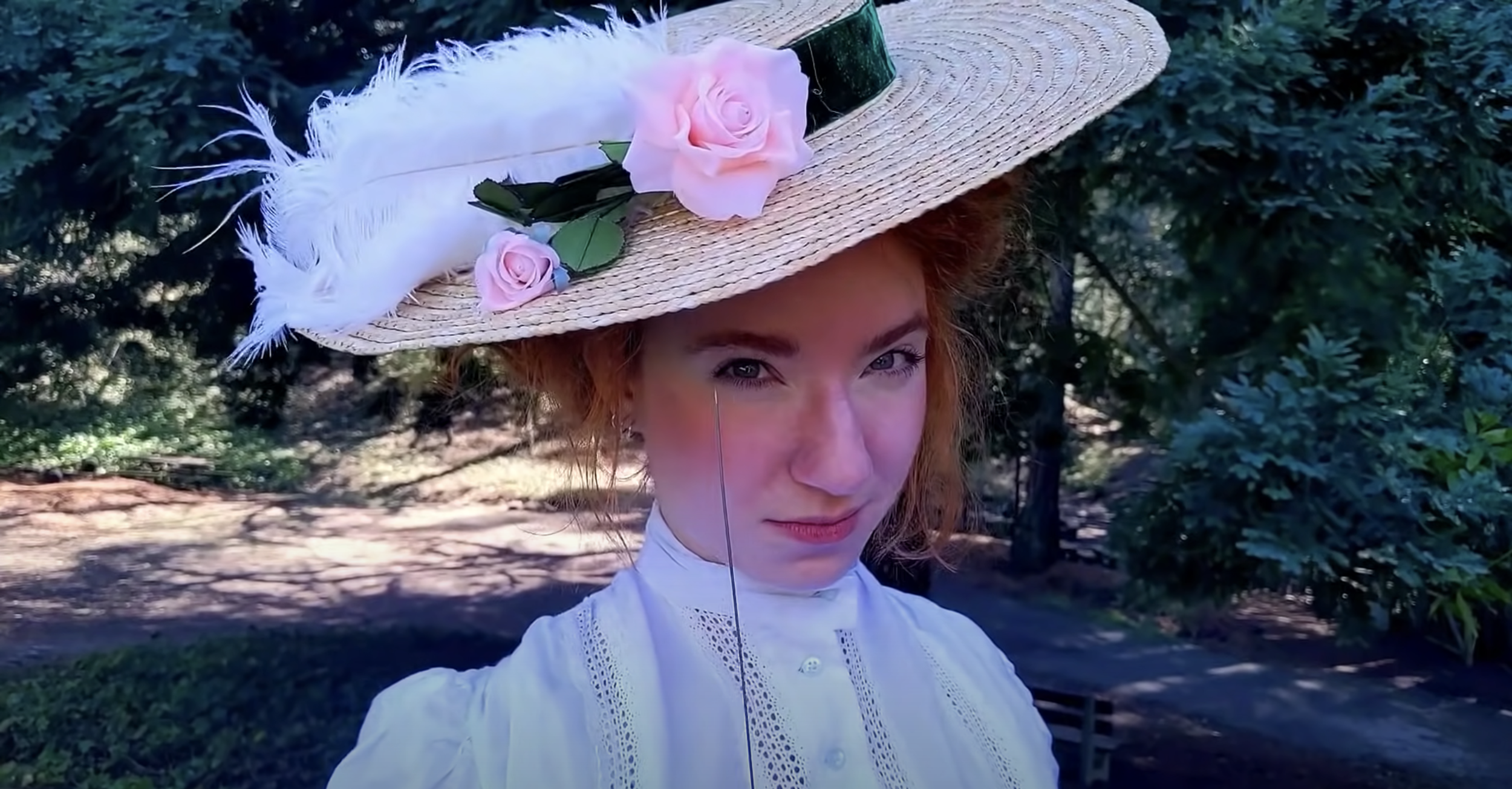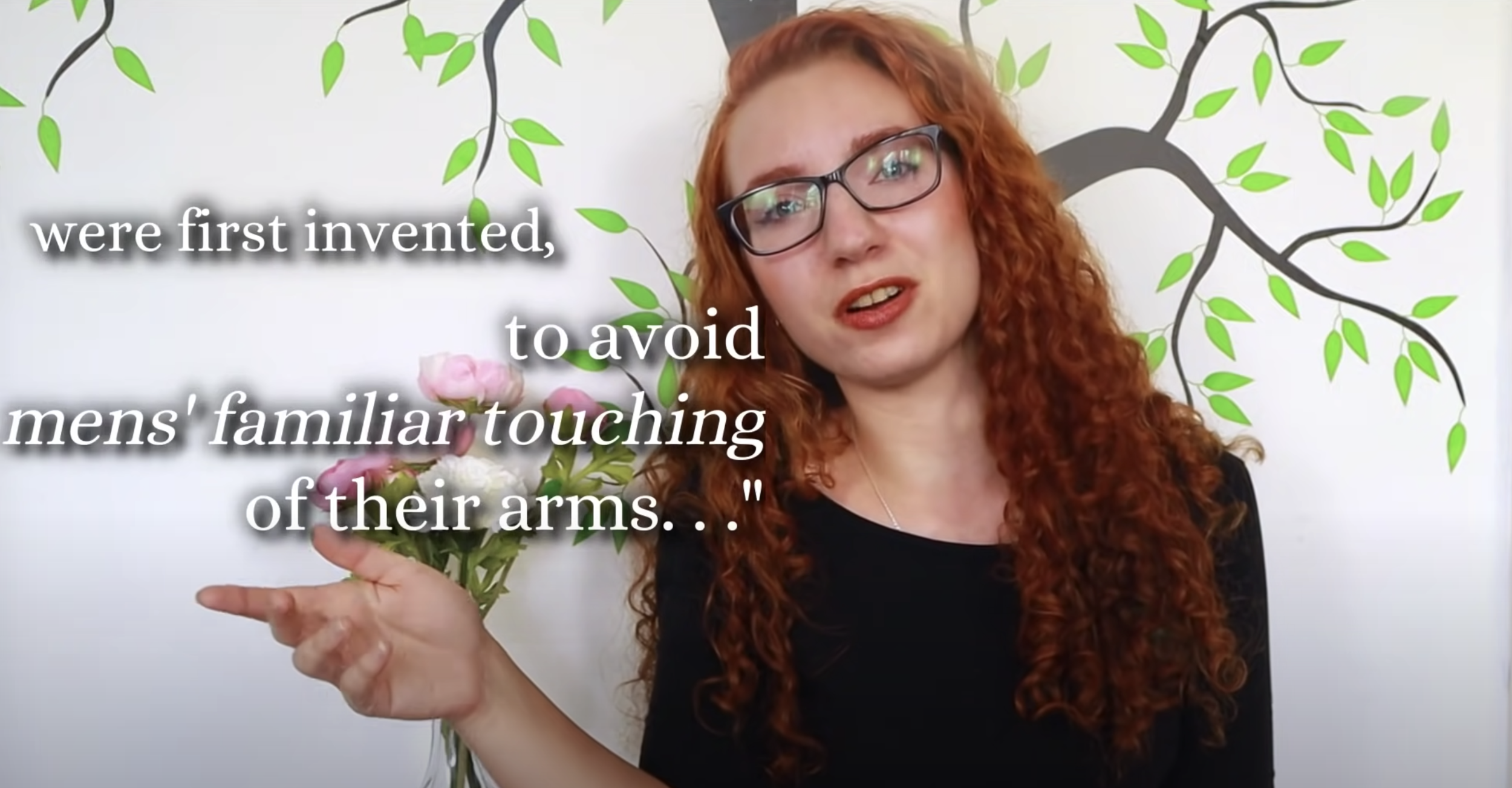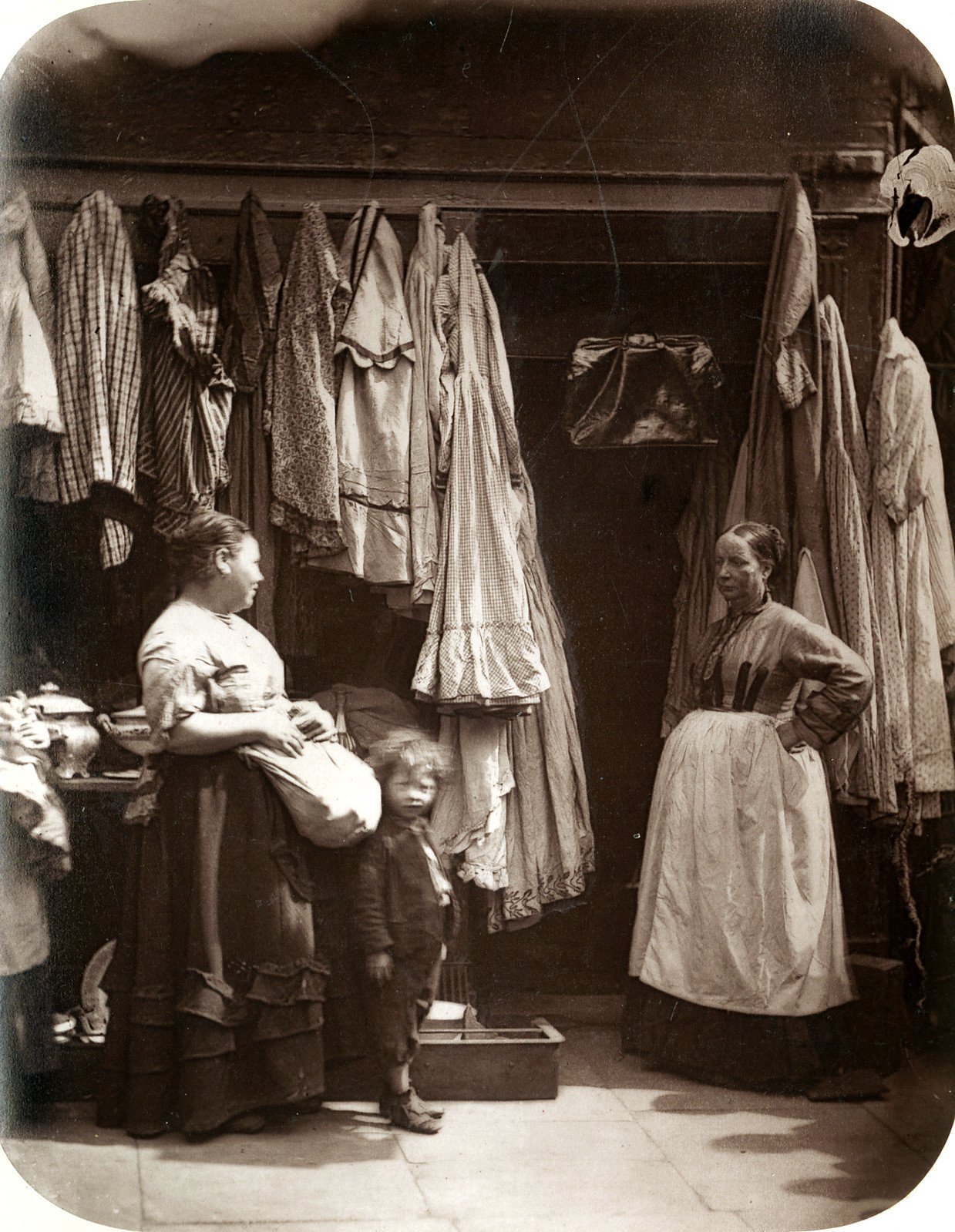Historical Costume vs Catcalling : Feminist fashion trends men hated
Historical Costume vs Catcalling :
Feminist fashion trends men hated
"Fashion Trends Men Hate" isn't a new thing. Nor is street harassment or catcalling. Hoopskirts, hat pins, and more of these feminist historical fashion trends helped fight unwanted advances and catcalls by maintaining personal space, keeping men at a distance, symbolizing womens' power, and even LITERALLY STABBING men who grabbed women on the street.
“And they say, that the sleeves borne up with whale-bones, were first invented, to avoid mens’ familiar touching of their arms. . .”
Fascinated by a quote in Nora Waugh’s “The Cut of Womens’ Clothes, I dug into the fashion history and gender politics behind Elizabethan puffy sleeves, 18th century hoopskirts, Victorian crinolines and bustles, huge Regency bonnets and Edwardian hats, and the Hatpin Peril that led to bans all over the world! But most importantly, in the era of #MeToo and Time's Up, what this dive into the feminism of historical dress will show us, is that sexual harassment has NEVER been about what the victim was wearing. Men have been writing about womens' fashion for centuries, and you'd be surprised how many 18th century and Victorian magazines have articles that read like a modern list of "fashion trends men hate".
Just how old is this problem?
This goes back to the early 18th century with the resurgence of hoopskirts, and continued into the 20th century with the "Hatpin Peril"— a supposed epidemic of "mashers" (Edwardian slang for creeps) stabbed with hatpins for bothering women out in public. Inspired by a quote by 16th century traveler Fynes Moryson (reprinted by Nora Waugh), and a tumblr post about how no one actually thought bustles were fake butts, I combed through dozens of ancient magazines and newspapers to figure out why men of the past couldn't handle Women Wearing Clothes.
Did it actually work?
Dress history tells us a fascinating story about how historical dresses prevented men grabbing arms, kept unwanted male advances at a distance, and in a pinch defended against violence. They also empowered women! From Queen Elizabeth I dazzling her courtiers in huge dresses, to 18th century women flirting on purpose with their hoopskirts, Victorian working-class women breaking down class barriers with fashionable clothes, and Edwardian women going places on their own, safe in the knowledge they carried concealed weapons, fashion and feminism have always worked together in some ways.
-
[some guy] : Hey lady . . .
Whatcha got going on under all that skirt?
We’ve all been there. And by we, I mean basically everyone who isn’t a man (or doesn’t look like society’s idea of one). Some foolish guy just does not understand that you do not want your day interrupted, you have no interest in what’s on offer, and really no reason to take notice of him at all aside from the fact that he won’t get out of your way. It’s to the point that you wish you had some kind of armor, something that would keep these guys at a distance . . .
Well, historical fashion is right there with you.
Hi, I’m V, and I’m a huge historical costume nerd. A few years back when all those articles about “10 fashion trends men hate” were going around, I stumbled on a Tumblr post by Gilded Age Garbage Fire, discussing how all of the gigantic skirt supports from the Victorian era, instead of being instruments of patriarchal torture, would absolutely have been on a 19th century list of fashion trends men hated. I wasn’t even a fledgling costumer at this point, but I filed this post away for humor, if nothing else.
In 2020, now a Dickens Fair alumnus and fledgling CosTuber, I was reading that beloved fashion history treatise “The Cut Of Womens’ Clothes” by Nora Waugh, and came across the following gem of a quote from 16th century traveler and diarist Fynes Moryson written in 1592 : "And they say, that the sleeves borne up with whale-bones, were first invented, to avoid mens' familiar touching of their arms. . ."
And suddenly, the memory of that tumblr post came rushing back. There was something there. There had to be. 2018 could not possibly have been the first time men complained about how absurd feminine fashion was, nor could 1592 be the last time someone tried to invent clothing that would keep ill-mannered menfolk at arms length. There had to be more of these fascinating moments in fashion history, and I wanted to know about them.
Before I get going, a little housekeeping on the topic of gendered terms : There have always been human beings that didn’t fit neatly into society’s gendered boxes. However, fashion, as a function of society, was meant to represent and reinforce those binary gender roles. There’s nothing inherently male or female about a piece of clothing, only what meaning society assigns to it. So I will be using the terms “menswear”, “womenswear”, “masculine” or “feminine” styles in reference to what those fashions represented at their time. Also, while I’ve tried to avoid referring generally to people facing harassment as “women”, because people of all genders face harassment, I will sometimes be referring to those doing the harassing as “men”. Many of these historical examples refer specifically to male aggressors, and while there are certainly exceptions, current studies show that street harassment is done by men the vast majority of the time, regardless of the target’s gender. If that bothers you, maybe take a minute to think about why. While you do that, let’s talk about some clothes.
We’ll start with the whalebone-supported sleeves our Mr. Moryson was talking about. The quote was published in 1617, but written in 1592, describing the fashion for these extremely voluminous sleeves, seen here in portraiture. They first came into fashion during the Elizabethan period and stayed popular in some form through most of the 17th century, up until the revolution in dressmaking that was the Mantua in the 1680s. The 16th century saw the hoopskirt, then called a “farthingale” (with all sorts of spellings), become popular in Europe for the first time, so when large sleeves came into fashion, tailors began to use the same methods of making them take up space. An account for making one of Queen Elizabeth gowns lists “for a payer of vardingall sleves of holland cloth bented with whalsbone and covered with riben, 13 shillings and fourpence” . Holland cloth was a type of linen usually used for undergarments or household textiles, which makes me think these were meant to be worn under the gown sleeves to support them. They’re basically the ancestor of 1830s “sleeve plumpers”.
So were they actually invented to keep overly touchy-feely men from making contact? We don’t know for sure in what spirit Mr. Moryson recorded this quote, or who he heard it said by. What we do understand from dress historians is that in England, at least, having a Queen on the throne had some interesting effects on gender roles in fashion. The broad-shouldered menswear of her father Henry the 8th’s time all but disappeared, and instead of padding at the shoulders, doublets were padded in the belly, in a style called the “peascod”. Meanwhile, the womenswear silhouette expanded through the cone-shaped Spanish farthingale, then the even bigger French cartwheel farthingale, with sleeves growing to balance proportions. Elizabeth wanted, even needed to dazzle and intimidate her courtiers to be taken seriously as a reigning, unmarried Queen, so the fashions she set reflected her power. Women in their dresses took up more and more space, and had a more commanding presence, while masculine fashion became softer, prioritizing refinement and prosperity over aggression and brute strength. So, whether they literally kept wandering hands at bay or not, these whalebone-supported sleeves absolutely did represent an increase in womens’ social power.
Moving into the early 18th century, let’s talk about a garment that was such a big—and I mean big— deal, that someone wrote an entire short academic paper trying to figure out why the men of the early 1700s just Could Not Handle It: the hoopskirt. 18th century hoopskirts were initially round but quickly became oval-shaped, flatter in the front and back and holding the skirt out as far as possible at the sides. I’ve read many of the pissed-off letters that various men of the time wrote to newspapers and magazines, in the hopes of making sense of the variety of things they’re mad about, and I’m still not sure I can. The academic paper in question is written by Kimberly Chrisman, and I found it extremely useful when combing through 18th-century publications for info. Complaints about the hoop petticoat included : It was a perversion of the figure to men who thought women were nature’s masterpiece; it was “mechanical” or a “machine” and therefore against gender roles that considered technology to be inherently masculine, it made all women look pregnant, encouraged adultery or extramarital affairs, showed frivolity and slavery to constantly-changing fashion, confused class distinctions as servants wore their employer’s cast-offs, oppressed men who had to buy them for their wives and daughters . . .
{hand to chest, out of breath}
And as if all this wasn’t enough, the thing that men were most resoundingly upset about was how women might use the hoop petticoat to deflect or initiate flirting, at their own choice. There’s much discussion of the idea that because a hoopskirt could conceivably be upset by wind, the wearer’s steps, or any number of other things, the wearer could deliberately use it to flash her legs, and have a defense of plausible deniability against slut-shaming. A poem from The Gentleman’s Magazine in 1745 reads “How their steps they reveal, and oblige the lewd eye/ With the leg's pretty turn, and delicate thigh,/ While the modern free hoops, so ample and wide,/ Up-lift the fair smock, with an impudent pride,/ And betray the sweet graces they chastely shou’d hide!”. And in 1753, a French poetic recipe for the latest fashions says “Make your petticoats short, that a hoop, eight yards wide/ May decently show how your garters are tied!”. Garters were usually tied just below or above the knee, and intensely sexualized.
But, the hoop petticoat could also keep unwelcome advances at a distance— if the wearer chose. In 1711, Joseph Addison writes in the Spectator “ I find several Speculative Persons are of Opinion that our Sex has of late Years been very sawcy, and that the Hoop Petticoat is made use of to keep us at a Distance. It is most certain that a Woman's Honour cannot be better entrenched than after this manner, in Circle within Circle, amidst such a Variety of Out-works and Lines of Circumvallation. A Female who is thus invested in Whale-Bone is sufficiently secured against the Approaches of an ill-bred Fellow.” In Samuel Richardson’s novel Clarissa, written in 1747, a character says “I desire my hoop may have its full circumference. All they're good for, that I know, is to clean dirty shoes and to keep ill-mannered fellows at a distance”.
All I can really conclude, is that these men couldn’t handle the idea of a woman having space that she alone could control. I’ll finish with the end of one Mr. Stonecastle’s rant on January 31st of 1741 to the London Magazine : “I know no other argument should sooner prevail with [women], than to acquaint them it is a Mode very disagreeable to the Men in general.”
Oh, how little has changed.
The next thing I came across is almost certainly a purposeful satire, but it’s so funny I couldn’t not talk about it. It’s one of those moments when someone tries to mock a thing for being completely ridiculous, and instead only succeeds in making themself look ridiculous for caring. Part of me wonders if this illustrator was self-aware enough to be doing this on purpose? But given this related work, I’m not so sure . . .
This cartoon published by Aaron Martinet depicts what are called “poke bonnets”. This style of hat dates from the late 1810s through the 1830s, a period of fashion history known for exuberant and excessive decoration as the minimalist Directoire styles of the Regency period were replaced. These bonnets were so big and so in-the-way one might assume it was tricky to have a conversation with the wearer, and that’s what the cartoon seems to be saying . . . until we look a little closer at just how those, uh, conversations, seem to be going. The frontmost pair of figures have what looks like entirely normal body language and posing, except for the fact that the gentleman’s head has fully disappeared within the brim of the lady’s bonnet for purposes we can all guess at. Her body language seems pretty neutral, and given the title of the piece translates to “the invisible face-to-face”, if it were just these two figures it would probably be a cute, silly little piece about clumsily-concealed smooching.
But let’s look at the second, uhm, conversation. This gentleman has not succeeded in shoving his entire head in the lady’s bonnet, only his face, because she is not having it. Look at her body language. From her head to her toes, she wants him out of her face— literally! She’s bracing with her legs, her entire body is leaning back to put more space between them. She’s pushing him away with both arms. Her head is pulling back so far her neck is disproportionately extended in the drawing. This isn’t cutesy smooching under cover of bonnet, this is assault.
In the background, we see two more ladies, both wearing the same exaggerated style of poke bonnets, cheerfully conversing with eachother from what might even be a Covid-19 safe distance, with no apparent problems.
Imagine setting out to mock hats for making it hard to talk to women, and instead illustrating for everyone that the hats are definitely not why you find it hard to talk to women.
And now we reach the topic of Gilded Age Garbage Fire’s truly wonderful Tumblr post, the gloriously voluminous skirt shapes of the Victorian era. At the start of the era, the fashionable skirt shape was a large bell, requiring layers upon layers of starched, corded, or horsehair-stiffened petticoats to create. These were heavy, expensive, and hard to move in— and before someone goes “then why did people wear it?”, let me explain that that was the point, kind of. If you were wearing all those layers of petticoats, then you were someone who could afford not to work. In a society with much more rigid ideas about social class than our modern Western world, you wanted to dress as well as you possibly could, because poverty was seen as immoral (for the poor people, mind, not for the society that didn’t help them).
Around 1856, some clever individual had the idea of using thin rings of flexible spring steel, held up by ribbons or fabric tapes into a cage-like structure, to support the bell-shaped skirts instead. These were much lighter, less expensive, and required less labor to keep in good condition than all the petticoats, so they took off immediately among the middle and lower classes who, of course, also wanted to walk down the street feeling like they looked amazing. And, just like in the 18th century, men lost their shit. Gilded Age Garbage Fire has provided a choice selection of satirical cartoons from the 1850s and 60s when hoopskirts were in fashion, all of them making fun of the size of the hoopskirts, how impractical they were, how much women cared. Satirical cartoons in the magazine Punch especially ridiculed maids and working-class women who wore crinolines, as did George Routledge’s etiquette manual from 1875. And, you can imagine how well racist white women took it as increasing numbers of Black women had the freedom and economic power to dress as fashionably as they pleased. While it is true that hoopskirts were a major risk when it came to working with machinery or fire, a lot of this outrage had nothing to do with safety, and was simply because these women were breaking down class barriers by “daring to dress above their station”.
Fashions changed in the late 1860s, with the hoopskirt first becoming bigger at the back, then evolving into the bustles of the 1870s and 80s. These are often called “fake butts” by modern people, but no one in the Victorian era actually thought that. Padding and skirt support garments had long since been part of fashion, and most people knew that human bodies were not actually shaped like whatever the fashionable silhouette was. That didn’t stop the satirists from having a field day with all the things the fashionable silhouette was shaped like, including centaurs, beetles, and snails. And there’s the great double-standard of sexism : Throughout history, things that women are excited about have been promptly demeaned and dismissed, whether it’s fluffy skirts, Starbucks and Uggs and pop music, or working in jobs like computer science. Yes, working with computers used to be low-paid secretarial work until men realized it was a big deal. Look it up if you don’t believe me.
And finally. My favorite out of all these trends, because it’s the only one that involved steep consequences for men who couldn’t keep it to themselves : the Hatpin Peril. As we have seen earlier, in the late-Victorian period through the 1910s, large fashionable hats and hairstyles needed to be attached to eachother with “hatpins”. These long, slender metal pins have a sharp point for piercing through the hat, and need to be at least as long as the hat’s crown is wide. This one is an original Edwardian one and measures a fairly modest 9 inches, but they could be at least a foot long.
In May 1903, Miss Leoti Blaker had recently come to New York City from Kansas. She got on the 5th Avenue coach and sat down in the corner next to a well-dressed older man. He seemed harmless enough, but soon took advantage of the crowdedness of public transit to invade her personal space more and more. When he put his arm “back of her” (and we can very well guess what she meant by that), she said “I became so enraged I didn’t know what to do. At last I reached up and took a hatpin from my hat. I slid it around so that I could give him a good dig, and ran that hatpin into him with all the force I possessed.”
Miss Blaker then goes on to say this wasn’t the first time she’d defended herself with a hatpin: In Kansas, a man tried to steal her pocketbook while she was fidgeting with her hat, so she jabbed him in the face and he ran off. She concludes her conversation with the reporter by saying “I will get rid of all the mashers that come near me”. “Masher” was the period term for a “catcaller” or “creep”, a man who hung around harassing women in public.
Miss Blaker wasn’t the first woman to use a hatpin as an improvised weapon— the San Francisco Call in 1898 contains a letter describing how a woman with a hatpin stopped a train robbery there, then admonishes “Let the men who have been punctured by it examine their own consciences”. However, Miss Blaker’s bravery did get a great deal of press, and while public opinion initially agreed that a hatpin was a suitable last-resort in defense of feminine virtue, it turned as soon as men began associating it with suffragists and other proponents of womens’ rights. Newspaper articles began to talk about the danger of hatpins, while in the wearer’s hat, injuring men in crowds— men specifically, not “people” so I do wonder if that had more to do with the men than the hatpins. Magazines published letters complaining that any man who tried to say anything to a woman he met might find himself stabbed. Sound familiar, in the age of Me Too and men complaining they’re afraid to speak to women at all in case whatever they say could be considered harassment? Some very insecure person even drew this cartoon, as if women don’t feel like this when someone’s staring aggressively at them . . .
Chicago banned hatpins longer than 9 inches in March of 1910. Various other places including Massachusetts, New Orleans, and Melbourne Australia, put similar laws in place, either restricting the length of hatpins or requiring them to have protective caps on the ends at all times to avoid accidental injuries. This was an extremely effective reframing tactic, in a few short years taking the discussion from lauding the brave women who defended themselves to blaming them for public endangerment of innocent men . . . all while taking attention away from the men whose awful ideas about consent led to them getting stuck with the pointy end. It was neither the demise of street-harassment nor anti-hatpin laws that ended the Hatpin Peril, but fashions moving ever onwards towards the shorter hairstyles and smaller hats of the 1920s.
So, I think the biggest lesson to be taken here, is this : Street harassment was a problem when people were wearing floor-length dresses and sleeves you couldn’t touch their arms through. It was a problem when they wore hats you couldn’t see their faces around, or hoopskirts so big you couldn’t stand next to them. It was a problem when you could literally expect to be stabbed for it with a hatpin— and despite all that, it’s still a problem today. Why? Because it has nothing to do with what you’re wearing. Street harassment has existed from now back to 1592 and probably to the dawn of human history because of one simple constant : Men who won’t leave us the fuck alone. It’s not because of what we’re wearing, it’s because of people who feel entitled to degrade others on the street, demand their attention, and violate their privacy and personal space. So if you’re watching this, and thinking about a time someone catcalled you and you wondered if you shouldn’t have worn that dress, or those shoes, or been out by yourself . . . No. It’s not your fault. It’s never your fault. It never has been and it never will be. And if you’re . . . somehow, still, watching this, wondering what is an acceptable reason to loudly hit on someone in the street if not their clothing . . . there isn’t one. It’s just never going to work out well for you. Please, go, work on being an interesting human being with character and hobbies and relationship skills . . . or if that sounds too hard, and you’d rather keep up the catcalling . . .
Thank you for watching this veritable diatribe on feminism and fashion history. If you’ve had fun, leave a like, tell me your thoughts in the comments, and subscribe to watch me make some of the exciting bits of costume we’ve talked about! Very heartfelt thanks to my friends Anna, for doing camera operation, and Christopher, for being the only one of my male friends who was willing to shout rude pickup lines at me on film.
Also some very heartfelt, if somewhat frustrated thanks to all the rest of my male friends, who could not have catcalled even convincingly enough for that scene. Building the world we want to live in right here.
Christopher : Whatcha got going on under . . . pthbbt . . . skert.
V : [laughing]
Christopher : I’m not a film actor!
V : Oh my god that’s excellent.







